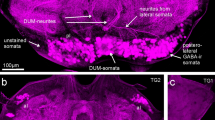Summary
The bombykol analogue (Z,E)-4,6-hexadecadiene elicits nerve-impulse firing in the bombykol receptor cell of male moths ofBombyx mori. It is about 100 times less effective than bombykol if one compares equipotent loads of the odor sources. However, brief (1 s) hexadecadiene stimuli are followed by after-responses lasting for more than 10 min, much longer than those following bombykol stimuli yielding equal initial responses. The possibility is discussed that the unusual type of response to hexadecadiene is produced by a combination of long-lasting excitatory and shortlasting inhibitory effects on the receptor cell. Alternatively, hexadecadiene could be a weak activator which is converted on the antenna into a more potent compound. The after-responses can be reversibly inhibited by linalool stimuli. The electrophysiological effects observed led to the prediction that a single stimulus with (Z,E)-4,6-hexadecadiene followed by repetitive pulses of linalool should simulate a response to pulsed bombykol stimuli and elicit anemotactic behavior of maleBombyx mori.
Similar content being viewed by others
References
Den Otter CJ, Schuil HA, Sander-van Oosten A (1978) Reception of hostplant odours and female sex pheromone inAdoxophyes orana (Lepidoptera: Tortricidae): Electrophysiology and morphology. Entomol Exp Appl 24:570–578
Kaissling KE (1974) Sensory transduction in insect olfactory receptors. In: Jaenicke L (ed) Biochemistry of sensory functions. Springer, Berlin Heidelberg New York, pp 243–273
Kaissling KE (1977a) Control of insect behavior via chemoreceptor organs. In: Shorey HH, McKelvey JJ Jr (eds) Chemical control of insect behavior: theory and application. Wiley, New York, pp 45–65
Kaissling KE (1977b) Structures of odour molecules and multiple activities of receptor cells. In: Le Magnen J, MacLeod P (eds) Int Symp Olfaction Taste VI. Information Retrieval, London, pp 9–16
Kaissling KE (1986) Chemo-electrical transduction in insect olfactory receptors. Annu Rev Neurosci 9:121–145
Kaissling KE (1987) In: Colbow K (ed) R.H. Wright lectures on insect olfaction. Simon Fraser University, Burnaby BC Canada
Kaissling KE, Thorson J (1980) Insect olfactory sensilla: structural, chemical and electrical aspects of the functional organization. In: Sattelle DB, Hall LM, Hildebrand JG (eds) Receptors for neurotransmitters, hormones and pheromones in insects. Elsevier/North Holland, Amsterdam, pp 261–282
Kaissling KE, Kasang G, Bestmann HJ, Stransky W, Vostrowsky O (1978) A new pheromone of the silkworm mothBombyx mori. Sensory pathway and behavioral effect. Naturwissenschaften 65:382–384
Kaissling KE, Kramer E, Meng LZ (1988) Zeitliche Modulation der Riechzellenantwort als Voraussetzung für anemotaktisches Verhalten vonBombyx mori. In: Eisner N, Barth FG (eds) Sense organs. Proc 16th Göttingen Neurobiology Conf. Thieme, Stuttgart New York, Abstr No 61
Kanaujia S, Kaissling KE (1985) Interactions of pheromone with moth antennae: adsorption, desorption and transport. J Insect Physiol 31:71–81
Kramer E (1986) Turbulent diffusion and pheromone triggered anemotaxis. In: Payne TL, Birch MC, Kennedy CEJ (eds) Mechanisms in insect olfaction. Oxford University Press, pp 59–67
Priesner E (1979) Progress in the analysis of pheromone receptor systems. Ann Zool Ecol Anim 11:533–546
Schneider D, Lacher V, Kaissling KE (1964) Die Reaktionsweise und das Reaktionsspektrum von Riechzellen beiAntheraea pernyi (Lepidoptera, Saturniidae). Z Vergl Physiol 48:632–662
Van der Pers JNC, Den Otter CF (1978) Single cell responses from olfactory receptors of small ermine moth to sex attractants. J Insect Physiol 24:337–343
Van der Pers JNC, Cuperus PL, Den Otter CJ (1980) Distribution of sense organs on male antennae of small ermine moths,Yponomeuta spp. (Lepidoptera: Yponomeutidae). Int J Insect Morphol&Embryol 9:15–23
Author information
Authors and Affiliations
Rights and permissions
About this article
Cite this article
Kaissling, K.E., Meng, L.Z. & Bestmann, H.J. Responses of bombykol receptor cells to (Z,E)-4,6-hexadecadiene and linalool. J. Comp. Physiol. 165, 147–154 (1989). https://doi.org/10.1007/BF00619189
Accepted:
Issue Date:
DOI: https://doi.org/10.1007/BF00619189




